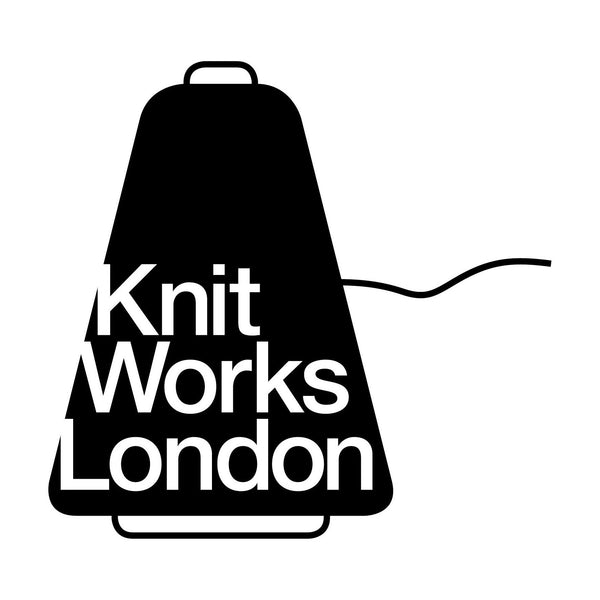
An Introduction to Dubied Industrial Knitting Machines
Share
Transcript
This is a Dubied industrial knitting machine. There are other brands too but Dubied was the fanciest, and it’s what we have at Knit Works London.
These are what commercially produced knitted garments were made on before production went digital and they’re still perfect for design experimentation and small scale production.
We sell the finest machine knitting yarn online and in store, teach machine knitting classes, and also hire knitting machines to use in our east London studio.
Dubied machines were produced in Switzerland from the late 1800s until the 1980s. They’re industrial pieces of equipment so they’re big, heavy and expensive, and now they’re getting rare. But they were built to last.
So who uses them? They’re present in the workshops of most fashion and textile university courses that teach knitwear. Because lots of the students will be producing their knitwear on these machines, and knitwear brands will expect graduates to know how to use them.
Some knitwear brands will have Dubieds in their design studios, and small scale producers too.
In industry, they are mainly used for design development. Sampling, testing techniques and yarns, colour combinations, and making swatches to send to a factory. This enables the designers to take hands on control of the fabric design.
You can knit something and immediately see if it looks right. In contrast if you drew something on the computer, sent it off to the factory, they had to programme their machines, knit it and send it back – and what comes back might not even look right. So that would take much more time and cost much more money.
So being able to develop fabrics yourself as a designer, using the Dubied, makes the design process far more efficient and cost effective.
There are several differences between a domestic knitting machine and an industrial. Domestic machines come in Chunky, Standard and Fine gauges. Dubieds come in dozens of different gauges, each tailored for specific different thicknesses and garment types.
The gauges are named for how many needles there are per inch. So the more needles per inch, the finer the gauge. At Knit Works London we have a 2.5gg, which is Aran. 7gg, which is similar to a standard gauge domestic, 8gg which is similar to a fine gauge domestic. 10gg bridges the gap between this and the 12 which is a fine gauge T shirt thickness.
On a domestic machine we can add a ribber to create a double bed fabric. Whereas a Dubied is designed as a double bed machine. There are two types of needles. High and low butts. We can set these up before we start knitting to knit different patterns and techniques. And the carriage is split into for carriages - front, back, left and right – each with its own tension, knitting and tucking levers. This allows you to be doing different things on different beds in different directions.
You can change yarns just by moving a lever, so it’s much faster. And the beds are longer so you can knit bigger pieces of fabric.
The carriages move more smoothly with less resistance. People mostly stand up to knit with them so can put your full body into it and it feels more of a natural movement. So they’re faster to knit with overall.
These are industrial machines made from cast iron, designed for production at a fast pace, in a factory setting. Whereas a domestic machine has some plastic parts, these are all metal. So they’re robust, and built to last.
Using the dubied can be a lot to get your head around! But once mastered, you can knit anything from T-shirts up to aran wooly jumpers in a range of amazing patterns and techniques.
And understanding how to knit on a dubied, helps you understand digital production as well, both the terminology, what the different techniques are called – so you sound like an expert – and the actual process of knitting, what the machines are doing, and what’s possible for them to do. Since the digital machines are like motorised versions of these industrial machines, so the parameters of what they can do is quite similar.
So if you’re working as a designer, you’ll be able to work with factories much more efficiently if you can knit with a Dubied. You’ll understand what can and can’t be done, so you’ll understand the constraints and creative opportunities. If you find yourself working with a digital machine programmer in a factory who hasn’t worked on a particular technique before, you’ll have the understanding to help make it possible.
Examples
You can come to Knit Works London to hire our Dubied machines. All the details are on knitworkslondon.com.
We also teach dubied courses. – we have an intensive 5 day Dubied Industrial Knitting Machine course, covering all the features and techniques of the Dubied. This will give you a really good grounding on using them, and you leave with a technical folder full of techniques.
And also a course following on from this – which you could join if you’ve used a Dubied before – showing you how to make a fully fashioned T-shirt on the Dubied.
Check out knitworkslondon.com for details. So like and subscribe for more machine knitting content and we hope to see in a class or in the shop soon!